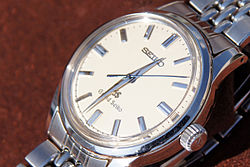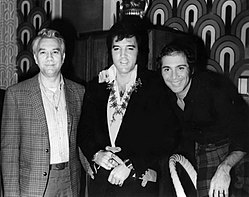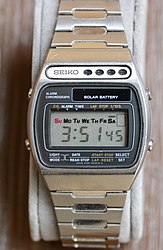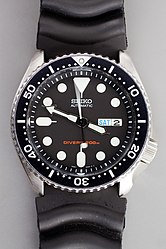Seiko
| Seiko Holdings Corporation
|
|
|---|---|
| legal form | Kabushiki gaisha (joint stock company) |
| ISIN | JP3414700009 |
| founding | 1881 |
| Seat |
Ginza , Chūō , Tokyo Prefecture , Japan |
| management | Shinji Hattori (President) |
| Number of employees | approx. 13,000 |
| sales | approx. € 2.5 billion |
| Branch | Watchmaking, precision instruments, optical products |
| Website | www.seiko.co.jp |
| Status: 2015 | |
Elvis Presley with a Seiko LCD Alarm Chronograph (1972)
The SBDX001 Marinemaster was the first Seiko with a monocoque case .
Seiko (officially Seiko Holdings KK) is an independent watch group headquartered in Tokyo ( Japan ). The company completely dispenses with suppliers and produces all components , raw materials , operating and auxiliary materials 100% in-house. This type of watch production is unique worldwide. Seiko is wholly owned by the Hattori family.
Company history
Company foundation (1881)
In 1881, Kintarō Hattori (1860-1934) founded a watch repair shop in what is now the Ginza district of Tokyo . At that time it was still operating under the name Hattori Tokeiten (Eng. "Hattori watchmaker's shop"). In 1892, Hattori also acquired a disused factory building in the Sumida district of Tokyo , where he founded a watch factory under the name Seikōsha with the aim of producing Japan's best wall clocks. Seikōsha is an acronym and stands for Seikō (dt. Precision) and Sha (dt. House), so precision house . The successful sale of wall clocks encouraged Hattori to expand the product range of his company. In 1895 he designed a pocket watch called Timekeeper . In the early 1900s, Seikōsha was the largest manufacturer of pocket watches, alarm clocks and wall clocks in Japan at the time.
First wristwatch in Japan (1913)
The first wristwatch , which was 100% made in Japan, was a product of the Seikōsha company and was manufactured under the name Laurel in 1913. In 1923, the Great Kantō earthquake destroyed the headquarters in Ginza and the Seikōsha factory in Sumida. Kintarō Hattori invested all of his private assets and built the company from scratch.
Seiko as a brand name is introduced (1924)
In 1924, the very first wristwatch with the SEIKO imprint on the dial was produced. In the same year, the SEIKO brand name was also protected by patent . In 1929 the Japanese State Railways appointed Seiko as the official supplier for timekeeping in rail operations .
Technology innovations
In 1956, Seiko introduced the Diashock shock protection . In 1959, Seiko developed the Magic Lever . The Magic Lever was a new type of component for the elevator mechanism. By using the flywheel, regardless of the direction of rotation, it increases the efficiency of the automatic elevator. This component is attached directly to the shaft of the flywheel and thus ensures an even more efficient lift. In 1963 the Swiss Cantonal Observatory in Neuchâtel allowed Seiko to participate in watch competitions. Seiko took second and third place. Seiko sent 45 caliber movements to Neuchâtel, which were later developed for Grand Seiko watches. Back then, these watches were marketed as specially calibrated timepieces . In 1965 Seiko introduced the first mechanical diving watch from Japan, the 62MAS . In 1966 the 62MAS proved its reliability during the 8th Japanese research expedition in Antarctica. At that time, this diving watch had a water resistance of 150 m.
The world's first quartz watch (1969)
In the 1960s, Seiko ran a race with the Swiss watch company Rolex for the world's first quartz wristwatch. The Japanese won the race and in December 1969 presented the world public with the Seiko Quartz-Astron, the world's first quartz wristwatch ready for series production. Rolex (only) presented a quartz watch from its own production in April 1970. Invented by Seiko tuning fork crystal oscillator had a frequency of 8,192 oscillations per second (Hz), which had a rate deviation of only five seconds per day result. The Quartz-Astron was manufactured in a limited edition of 100 pieces and cost 450,000 yen (approx. 7,600 German marks ), which at the time was roughly the price of a Toyota Corolla .A Seiko automatic chronograph , with a yellow dial, was worn by William Pogue during the Skylab 4 mission between 1973 and 1974 in space. This Seiko automatic chronograph is the first chronograph to be worn in space. He became world famous under the name Pogue Seiko .
Grand Seiko since 1960
In 1960, Seiko introduced the luxury brand Grand Seiko . The very first Grand Seiko had a balance frequency of 2.5 Hertz. The power reserve was 45 hours and at that time had an accuracy of +12 to -3 seconds per day. At the time, the model in the gold-plated case cost 25,000 yen, which was four times the monthly salary of an office worker in Tokyo. The design of the model was simple, and the dial was marked Chronometer .
To this day, the caliber testing of Grand Seiko watches is much more extensive and time-consuming than that of the Swiss competitors. The technical factory test includes more positions, more temperature ranges and more days than the normal chronometer test by the independent Swiss inspection body COSC . Seiko calls these tests the Grand Seiko Inspection Standard . All Grand Seiko calibres begin with the same number, the 9th. According to Seiko, this numerically highest number stands for the pursuit of the perfect watch . A lion emblem, as a symbol of the brand, is engraved on the back of each individual Grand Seiko. The watches are offered in the upper price segment from € 2,000. Grand Seiko wristwatches have been officially available in Germany since 2010.
Invention of Spring Drive Technology (1999)
Since the late 1970s, Seiko has been researching hybrid drives so that they can be used in watch movements. The aim was to combine mechanical and electrical energy in wristwatches. With Spring Drive technology, Seiko introduced the accuracy of quartz watches in mechanical watches. Spring-Drive technology is based on electromagnetic pulses. The energy generated in this way is controlled by the tri-synchro regulation system and transferred to the torque of the second hand. Since Spring-Drive movements have no escapement, any turning movement is in one direction so that the second hand glides over the dial without ticking .
Spring-Drive works guarantee an accuracy of only one second deviation per day.
A special alloy in Spring Drive movements increases the resistance to temperature fluctuations and at the same time reduces the aging of the movements. The power reserve in Seiko's Spring Drive movements is at least 72 hours. Seiko only offers these movements for wristwatches in the upper price segment.
In 1999, Seiko launched the very first watch with Spring Drive technology.
Company headquarters
The Seiko Group has its officially registered seat in Tokyo's Chūō district , in the Ginza district. The company has been listed on the Tokyo Stock Exchange since 1949 and, as the holding parent company under the name Seikō Holdings KK, is responsible for the subsidiaries Seikō Watch, Seikō Clock, Seikō Precision and Seikō Optical Products. President of Seikō Holdings KK has been Shinji Hattori, a great-grandson of Kintarō Hattori, since April 30, 2010.
Seiko Germany is based in Willich .
James Bond product placements
- Between 1977 and 1983 Seiko was the official watch outfitter for the James Bond films with Roger Moore . As early as 1973, Moore carried a Pulsar P2 2900 LED in the film Life and Let Die . Pulsar is now a Seiko subsidiary.
- The Spy Who Loved Me (Seiko 0674 LC)
- Moonraker - Top Secret (Seiko M354)
- Deadly Mission (Seiko H357 5040)
- Octopussy (Seiko G757 and Seiko TV-Watch DXA001 / 002)
Developments since 1881
- 1881 Kintarō Hattori (1860-1934) founded a watch repair business in Tokyo.
- 1892 Kintarō Hattori opened a factory under the name Seikōsha and produced its own wall clocks and alarm clocks.
- 1895 Seikōsha produces pocket watches for the first time under the name Timekeeper.
- 1913 The first Japanese wristwatch was manufactured by Seikōsha under the name Laurel.
- 1924 Seikōsha introduced Seiko as a brand name, and for the first time the name Seiko is printed on a clock face.
- In 1929 Seiko became the official supplier for the Japanese State Railways .
- 1956 Seiko introduced the Diashock shock protection .
- 1959 The Magic Lever (self-winding) was first introduced in the Seiko Gyro Marvel.
- In 1965, Seiko manufactured the first mechanical diving watch from Japan with the 62MAS .
- 1969 The world's first quartz wristwatch Seiko Quarz Astron was introduced.
- 1972 Introduction of the world's first LCD quartz watch with a six-digit digital display.
- 1975 The world's first diving watch with case components made of titanium was presented.
- 1976 Introduction of the world's first quartz alarm clock.
- 1978 Introduction of the PYF18, the world's first diving watch with a quartz movement.
- 1982 Introduction of the world's first hybrid diving watch, the SAD017, with a bilingual display for underwater communication.
- 1983 The world's first TV watch, caliber DXV002 with screen, is introduced.
- 1984 Introduction of the world's first wristwatch with computer functions.
- 1990 Introduction of the world's first computerized diving watch "Scubamaster SBBK001".
- 1996 Introduction of the mechanical diving watch SKX007 . It was Seiko's longest-running watch. Production was only stopped in 2019.
- 1998 Introduction of the Seiko Thermic , the first wristwatch to be driven by an ultrasonic microrotor.
- 1999 Introduction of the world's first Spring Drive watch.
- 2000 Introduction of the SBDX001 Marinemaster .
- 2005 Introduction of the world's first three-band radio clock.
- 2006 The world's first watch with an electrophoretic display (EPD) was introduced.
- 2010 The world's first EPD clock with an active matrix system was introduced.
- 2012 The first watch with a built-in GPS receiver was presented at Baselworld 2012 .
literature
- John Goodall: A Journey Through Time. The remarkable story of Seiko. Seiko Watch Corporation, 2003.
- Stefan Hencke: Lexus for the wrist - watches practical test. In: GZ International Journal for Jewelry and Watches. Rühle-Diebener, October 2008, p. 72.
- Alexander Krupp: Inhibition in Japanese . In: Chronos. Ebner, March 2007, p. 92 ff.
- Martina Richter: The muscle man . In: watch magazine . Ebner, March 2009, p. 54 ff.
- Lucien F. Trueb: Precision counts again . In: Chronos. June / July 2009, p. 42 f.
- Frank Valentin: A touch of mechanics . In: Watch Lounge. The watch and lifestyle magazine . Dr. Peter Müller Buch- und Kunstverlag, 3/2008, p. 56 ff.
- Iris Wimmer-Olbort: The best of both worlds . In: watch magazine. Ebner, October 2008, p. 80 ff.
- Iris Wimmer-Olbort: Race for time. In: watch magazine. Ebner, September 2008, p. 96 ff.
Web links
- Seiko corporate website
- Seiko Germany website
- Seiko Austria website
- Seiko Astron (English, German)
Individual evidence
- ↑ Martin Häußermann: Watch giant Seiko: A lot of new things in the east . In: Frankfurter Allgemeine Zeitung . February 2, 2017 ( faz.net ).
- ↑ 5 facts about Seiko. watchtime.net.
- ↑ seikowatches.com
- ↑ blog.watchdoctor.biz
- ↑ uhrenkosmos.com
- ↑ grand-seiko.com
- ↑ The Story of Seiko , page on watchtime.net, accessed August 23, 2014.
- ↑ seikowatches.com
- ^ Nobuhiro Kubo, Nathan Layne, Hugh Lawson, Dan Lalor: UPDATE 1-Seiko fires president in rare Japanese dismissal. Reuters , April 30, 2010, accessed May 10, 2010 .
- ↑ seiko.at










